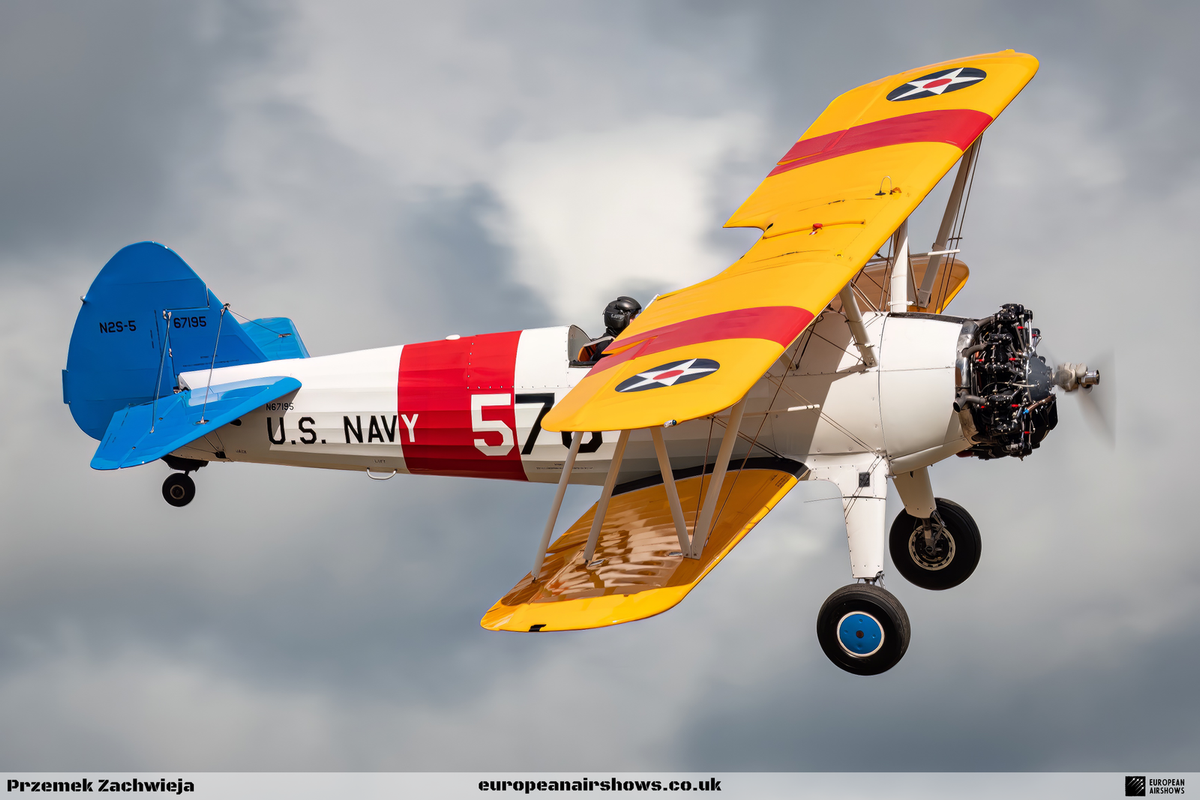
Boeing-Stearman N67195
About the Stearman
The Stearman (Boeing) Model 75 is an iconic American biplane that served primarily as a military trainer aircraft during the 1930s and 1940s. With over 10,626 units produced, this aircraft became a staple in the training programs of the United States Army Air Forces and the United States Navy, where it was known as the Kaydet. The Stearman’s rugged construction and open cockpit design made it an ideal platform for training new pilots. After World War II, many surplus Stearmans transitioned to civilian use, becoming popular as crop dusters, sport planes, and even as a canvas for aerobatic performances and wing walking in air shows. The aircraft’s enduring legacy is a testament to its versatility and reliability, making it a beloved symbol of aviation history.
Specifications
Crew
2
Length
24 ft 9 in (7.54 m)
Wingspan
32 ft 2 in (9.80 m)
Height
9 ft 8 in (2.95 m)
Max Speed
124 mph (200 km/h, 108 kn)
Range
505 mi (813 km, 438 nmi)
Service Ceiling
13,200 ft (4,000 m)
Rate of climb
800 ft/min (4.06 m/s)
A75N1 Variant
The A75N1 variant of the Stearman Model 75, designated as the PT-17, represents one of the most widely produced versions of this iconic biplane. Powered by the Continental R-670-14 engine, the A75N1 was designed to meet the needs of the U.S. Navy, which utilized it extensively for training purposes. With approximately 2,942 units delivered, the PT-17 earned the nickname “Yellow Peril” due to its distinctive yellow paint scheme. The A75N1 featured a conventional biplane design with tandem seating for a student and instructor, allowing for effective training in flight maneuvers. Its robust construction and ability to withstand the rigors of flight training made the A75N1 a reliable choice for military aviation, and its legacy continues to be celebrated in both civilian and military aviation circles today.
Did You Know?
- The Stearman Model 75, also known as the Kaydet, saw over 10,626 units built in the U.S. during the 1930s and 1940s, making it one of the most produced military trainer aircraft.
- After World War II, many surplus Stearman aircraft were repurposed as crop dusters, sports planes, and even for aerobatics and wing walking in air shows.
- The Stearman Model 75 was designed to withstand extreme forces, capable of withstanding +12g and -9g, which made it a durable choice for training pilots.
- The U.S. Army Air Forces designated the Stearman Model 75 with several designations, including PT-13, PT-17, and PT-18, depending on the engine type installed.
- The civilian version of the Stearman Model 75 was issued an Approved Type Certificate in 1941 and was designated as the Model A75L3 (PT-13) and Model A75N1 (PT-17).
Test Your Knowledge
1. How many Stearman Model 75 aircraft were built during the 1930s and 1940s?
A75N1 N67195
The Boeing Stearman N67195, originally constructed as a PT-17, has a rich history that reflects its service and subsequent civilian life. Built by Boeing in the late 1930s, it was taken on charge by the United States Army Air Forces with the serial number 41-8196. Following its military service, the aircraft changed ownership multiple times, transitioning from various registrations, including N54995 and YS-351A, before being acquired by Surplus Specialties Inc. in Cleveland, Michigan, on April 1, 1991. It received a new registration as N67195 and was granted a certificate of airworthiness on December 28, 1992, allowing it to operate in civilian airspace.
Tragically, the aircraft met a devastating fate on December 26, 2005, when it crashed at Hicks Airfield Airport in Fort Worth, Texas, during a climb after experiencing a complete loss of engine power. The accident resulted in one fatality and one serious injury, highlighting the inherent risks associated with aviation. The experienced pilot, who held an ATP rating and had logged 109 hours in the Stearman, attempted to avert obstacles while the aircraft entered a spin and subsequently impacted the ground. Following this incident, not much is documented regarding the aircraft’s restoration or its whereabouts until it resurfaced in Europe around 2018.
Currently, N67195 is based at Abbeyshrule Aerodrome in Ireland, where it is owned by David Bruton. Since its arrival in Europe, the aircraft has gained popularity among aviation enthusiasts in Ireland, frequently participating in airshows, fly-ins, and other aviation events. Its vibrant history and continued presence in the aviation community have made the Boeing Stearman N67195 a beloved attraction, showcasing the enduring charm and legacy of vintage aircraft.





